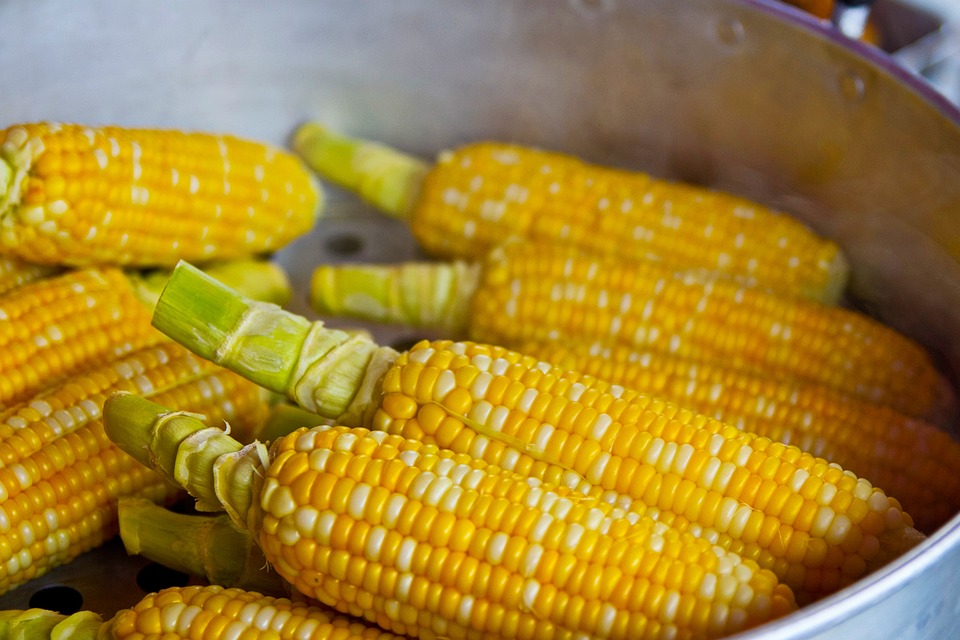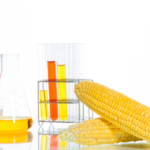Corn is a very popular food that is eaten by people all over the world. It’s also incredibly versatile. You can find corn in many places such as baked goods, breads, popcorn, and grilled on the cob. It is also given to cows, used as gas for cars, and is a common ingredient in processed foods. But is corn good for you? How do you choose the healthiest corn to eat?
What Is Corn?
Corn is a domesticated crop that was originally a Mexican grass called teosinte. Teosinte is corn’s closest relative and it is thought that corn originated from it over 8,700 years ago. Christopher Columbus
introduced corn to Europe around the late 1400s. The rest of the world became familiar with it through the travels and dealings of traders.
Typically, the British English use of the word “corn” refers to any type of grain. Many other countries around the world call it “corn.” But as an American, to avoid confusion, I’m just going to call it “corn,” if I may. (Sorry. Corny pun.)
This is a big question about corn. Is it a grain? Or a vegetable?
Apparently, that’s a bit of a gray area. Most people consider corn on the cob a vegetable. But the individual kernels are made up of whole grains. Kernels are seeds that can be planted to grow popcorn. That technically makes corn a fruit.
Is Corn Nutritious? Exploring the Health Benefits of Corn
The nutritional value of corn varies depending on the color and variety of the plant. Even though the majority of edible corn is nutritious, there are still many people who don’t believe in it.
A single medium-sized ear of sweet corn contains around 88 calories, 3 grams of protein, 19 grams of carbohydrates (including 2 grams of fiber and 6 grams of sugar), 2 milligrams of calcium, and 275 milligrams of potassium, according to the United States Department of Agriculture.
In addition to health-promoting antioxidants, edible corn varieties offers some other health benefits, too:
- Corn has many nutrients. It’s a good source of fiber, protein, B vitamins, and minerals like zinc, copper, manganese, magnesium, iron, selenium, and phosphorus. Whether you want to eat corn fresh, canned, frozen, or ground into cornmeal, you can reap these nutritional benefits year round.
- Corn may help keep your eyes healthy. Corn is high in lutein and zeaxanthin, which are carotenoid compounds naturally found in the macula of your eyes. Lutein and zeaxanthin in foods have been studied for their impact on preventing age-related macular degeneration (AMD). A study in JAMA found that of 365 adult men and women, those who consumed the highest amounts of these compounds had a 43% reduced risk of AMD compared to those who ate the lowest amounts.
- Corn may be good for your gut. The high fiber content of corn may also be good for your gut. Fiber is essential for digestive health. It’s been shown to reduce the risk for digestive diseases like colorectal cancer and diverticulitis. The fact that corn could be helpful with diverticulitis is particularly striking, considering that people with diverticulitis have traditionally been told to avoid eating popcorn. But a 2008 study published in JAMA followed over 47,000 men between the ages of 40 and 75, with no history of diverticulitis, for 18 years. Researchers found that men who ate popcorn at least two times per week had a significantly lower risk of developing diverticulitis than men who ate no popcorn. As a result of this and other studies, official recommendations are now being updated.
- Corn is gluten-free. Corn off the cob, or in its original state, is naturally gluten-free. However, some foods or recipes that include corn might contain gluten. If you have a gluten sensitivity or celiac disease, make sure to read all the ingredients. And look for certified gluten-free products.
- Corn has long been a part of traditionally healthy diets. Corn has been a staple food for Native Americans and an important source of nutrients for many nations throughout history. And numerous researchers suggest that switching back to more traditional foods like corn could significantly reduce the chronic diseases of modern society. A 2007 report on indigenous people in North America published in the Journal of Medicinal Food discusses this in more depth. Switching to a modern diet that’s high in sugar, processed food, and factory farmed animal products leads to far more health risks for these communities than their traditional diets based on rice, vegetables, legumes, corn, and wild game. Not surprisingly, eating the Western diet increases their risk of high blood pressure and diabetes dramatically.
What About Popcorn?
Popcorn is also low in calories and has a low glycemic index. Popcorn is a whole grain that is high in fiber and polyphenols, and low in calories and glycemic index. How the food is prepared is crucial. You can make a healthy snack unhealthy by adding unhealthy ingredients to it.
For example, many microwave popcorn bags contain perfluorooctanoic acid (PFOA), which has been linked to thyroid problems and ADHD. The oils in many packaged brands contain hydrogenated or partially-hydrogenated fats, which can contain harmful trans fats. And if it has fake butter in it? A chemical called diacetyl, which has been linked to a respiratory disease called cryptogenic organizing pneumonia, is often found in this. Yikes.
A healthier option for popcorn is air-popped popcorn instead of the commercially available popcorn that is processed with oil. You can try healthier toppings on your popcorn instead of mounds of melted butter and salt. Some possible seasonings for the dish include nutritional yeast, lemon juice, herbal seasoning, turmeric, curry powder, garlic powder, onion powder, and a dash of sea salt. Some people even try cinnamon. The possibilities are endless!
Risks, Side Effects and Concerns
1. When It’s Genetically Modified
Approximately 80 percent of foods in the average American diet contain some form of GMO corn-derived ingredient, with 88 percent of all corn grown in the U.S annually being genetically modified.
If you don’t know much about GMOs, they are exactly what they sound like- organisms whose genetics have been changed. The corn seeds are modified in a lab so that they will be resistant to predators such as weeds, insects, and rodents. GMOs are designed to create crops with defense mechanisms against pests and other threats.
Health concerns with GMO foods include:
- Changes in the gut environment
- Increased risk for antibiotic resistance
- Problems with hormonal (endocrine system) function
- Disorders of the reproductive system
- Increases in aging symptoms
When three different strains of GMO corn were fed to mice, the mice experienced negative reactions in their kidneys, livers, and detoxifying organs, according to a 2009 analysis published in the International Journal of Biological Sciences. The researchers found that the rats who ate GMOs had noticeable changes in their heart function, adrenal glands, spleens and haematopoietic systems. They believe that these changes were caused by the rats eating GMO seeds and that the rats showed signs of “hepatorenal toxicity.”
This crop is commonly used to make a genetically modified oil that is a strong inflammatory and highly likely to become rancid when used in cooking. The fatty acids in corn oil are delicate and prone to being damaged by heat and light. This means that the corn oil found on most grocery store shelves is probably already bad.
2. When It’s Used to Make High Fructose Corn Syrup
High fructose corn syrup is not natural, and it is not healthy. HFCS is a liquid sweetener that is made from fructose and glucose. It is an alternative to sucrose, which is the type of sugar that is typically found on tables. This text is discussing how high-fructose corn syrup is man-made and processed, and was first introduced in the 1970s as a cheap way to sweeten food.
HFCS contains more of the type of sugar called fructose than regular sugar does, and this can have different effects on the body. The debate continues over whether or not fructose, HFCS, or sucrose can lead to increased heart disease, metabolic syndrome, or fatty liver. High sugar diets are linked with poor health, obesity and various diseases. However, it is not clear if HFCS causes more weight gain than regular sugar. HFCS has been linked to accelerated tumor growth and size, raising concerns about cancer risk.
A quarter of an average American’s calories come from sugar, with most of that being fructose found in sweetened products and drinks. There are much better alternatives to processed sugar, like raw honey, blackstrap molasses, and pure maple syrup. You should only consume natural sweeteners in moderation and not rely on them as a major source of calories in your diet.
3. When It’s Found in Other Forms of Processed Foods
Many foods contain ingredients that come from genetically modified corn. Always check the food label before buying a product to make sure it is safe and there are no unrecognizable ingredients. Keep in mind that food manufacturers are constantly changing the ingredients in packaged foods, as well as their preparation methods. This means that even things you wouldn’t suspect of containing GMO ingredients might actually have them.
As noted on the Live Corn Free website, some ingredients which may indicate the presence of corn include citric acid, confectioner’s sugar, corn flour, caramel flavor, corn fructose, corn meal, corn oil, corn syrup, dextrin and dextrose, fructose, lactic acid, malt, malodextrin, mono- and diglycerides, monosodium glutamate, and sorbitol. This text is suggesting that you should avoid the boxed items in the middle aisles of the grocery store, and instead focus on the real, whole foods found on the perimeter.
4. If You Have a Sensitive Digestive System
What are the side effects of corn?
This vegetable can still cause problems for your digestion even though it is gluten-free and not technically a grain. If you have other common food allergies or problems with digesting FODMAP foods, this vegetable may cause you stomachaches.
Why does corn hurt your stomach?
The high fiber content and ability to ferment in the gut may be some of the reasons why konjac is effective in regulating blood sugar levels. Even though this food is rich in fiber, the cellulose it contains is a type of fiber that is difficult for humans to digest. The reason we can’t digest it properly is because we don’t have the right enzyme. In other words, certain types of fiber can cause gas and other digestive issues for some people. One way to make it easier to digest this vegetable is to puree, blend, or chew it longer.
If you have issues with corn such as bloating, changes in stool, diarrhea or gas, the best option is to avoid it and all its derivatives. You can try eliminating corn products from your diet by substituting pureed fruit or fruit juice, raw honey, coconut palm sugar, pure maple syrup, potato starch, rice starch, coconut flour, almond flour, or tapioca.
The Best Way to Enjoy Corn
When choosing corn, look for ears that are uniformly green and tightly wrapped. The corn cob should feel firm when squeezed all over. If the brown silk that’s peeking out of the top is slightly damp, that’s a good sign. If there are any holes in the husk, choose another one because it could be an indication of worms.
When you get home, wrap the ears in a plastic bag and place them in the refrigerator. Depending on the type of corn, it will usually stay fresh for a few days when stored in this manner. You can also freeze it. One way to preserve corn is to blanch it in whole form or just the kernels and then freeze it. This will help maintain its color, texture, and freshness.
If you want to eat corn, you need to remove the husk, or the leaves. Begin by removing the outer leaves, then the inner leaves. When you have removed all of the leaves and most of the silks from the corn cob, break the cob off the end. You will probably have some pesky silk left.



